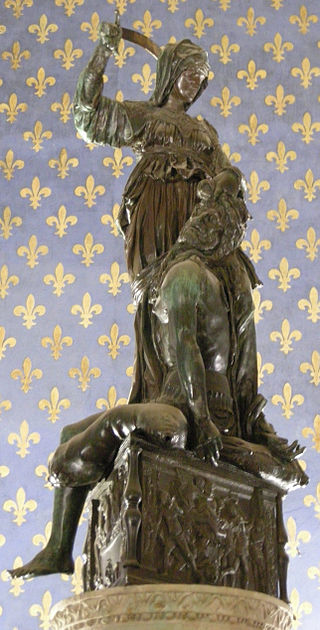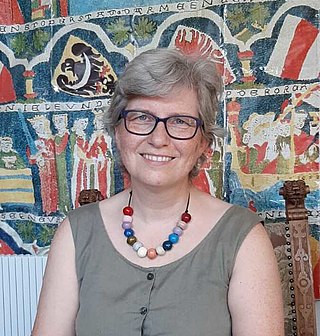Related Research Articles

Chloe, also spelled Chloë, Chlöe, or Chloé, is a feminine name meaning "blooming" or "fertility" in Greek. The name ultimately derives, through Greek, from the Proto-Indo-European root *ǵʰelh₃-, which relates to the colors yellow and green. The common scientific prefix chloro- derives from the same Greek root. In Greek the word refers to the young, green foliage or shoots of plants in spring.
Abra may refer to:

The Book of Judith is a deuterocanonical book included in the Septuagint and the Catholic and Eastern Orthodox Christian Old Testament of the Bible but excluded from the Hebrew canon and assigned by Protestants to the apocrypha. It tells of a Jewish widow, Judith, who uses her beauty and charm to destroy an Assyrian general and save Israel from oppression. The surviving Greek manuscripts contain several historical anachronisms, which is why some Protestant scholars now consider the book non-historical. Instead, the book may be a parable, theological novel, or perhaps the first historical novel. The name Judith, meaning "praised" or "Jewess", is the feminine form of Judah.
Melchior is the name traditionally given to one of the biblical Magi appearing in the Gospel of Matthew. There are many notable people with this name, or close variations.
Æthelburg was Queen of Wessex by marriage to King Ine of Wessex. Perhaps most famed for her act in 722, when she destroyed the stronghold of Taunton in an attempt to find the rebel Ealdbert.

Judith and Holofernes (1457–1464) is a bronze sculpture by the Italian Renaissance sculptor Donatello at the end of his career. It is located in the Hall of Lilies, in the Palazzo Vecchio, Florence, Italy. A copy stands in one of the sculpture's original positions on the Piazza della Signoria, in front of the Palazzo Vecchio.
Rónán, anglicised as Ronan, is an Irish male given name and surname. As a surname, it is derived from the Gaelic Ó Rónáin 'descendant of Rónán'. The name has several meanings such as 'seal', 'a pledge', and 'a promising oath'. The word for seal in Irish Gaelic is rón.
Megan is a Welsh feminine given name, originally a diminutive form of Margaret. Margaret is from the Greek μαργαρίτης (margarítēs), Latin margarīta, "pearl". Megan is one of the most popular Welsh-language names for women in Wales and England, and is commonly truncated to Meg.
Rocco is both a given name and a surname. Origin: Italian. Meaning: Rest, repose. Rocco is a boy's name of Italian origin. It is thought to derive from the Old German word "hrok", which means to rest or repose. The name is associated with a fourteenth-century Catholic saint, San Rocco, who tended to the ill during a plague. Notable people with the name include:

Roderick, Rodrick or Roderic is a Germanic name, recorded from the 8th century onward. Its Old High German forms are Hrodric, Chrodericus, Hroderich, Roderich, Ruodrich (etc.); in Gothic language Hrōþireiks; in Old English language it appears as Hrēðrīc or Hroðrīc, and in Old Norse as Hrǿríkʀ.
Ritter is a surname of German origin, and may refer to:
Biblical languages are any of the languages employed in the original writings of the Bible. Partially owing to the significance of the Bible in society, Biblical languages are studied more widely than many other dead languages. Furthermore, some debates exist as to which language is the original language of a particular passage, and about whether a term has been properly translated from an ancient language into modern editions of the Bible. Scholars generally recognize three languages as original biblical languages: Hebrew, Aramaic, and Koine Greek.

The account of the beheading of Holofernes by Judith is given in the deuterocanonical Book of Judith, and is the subject of many paintings and sculptures from the Renaissance and Baroque periods. In the story, Judith, a beautiful widow, is able to enter the tent of Holofernes because of his desire for her. Holofernes was an Assyrian general who was about to destroy Judith's home, the city of Bethulia. Overcome with drink, he passes out and is decapitated by Judith; his head is taken away in a basket.
Rémy, Remy, Rémi or Remi is a name of French origin, and is associated with the Latin name Remigius. It is used as either a surname or as a male or female given name.
Maxwell is a Scottish surname, a habitational name derived from a location near Melrose, in Roxburghshire, Scotland. This name was first recorded in 1144, as Mackeswell, meaning "Mack's spring ". The surname Maxwell is also common in Ulster, where it has, in some cases, been adopted as alternate form of the surname Miskell. The surname Maxwell is represented in Scottish Gaelic as MacSuail.
Bertrand is a given name and surname. In German, the name derives from berht ("bright") and hramn ("raven") or rand.

Henrike Lähnemann is a German medievalist and holds the Chair of Medieval German, University of Oxford. She is a Fellow of St Edmund Hall, Oxford.

Judith and Her Maidservant is one of four paintings by the Italian baroque artist Artemisia Gentileschi that depicts the biblical story of Judith and Holofernes. This particular work, executed in about 1623 to 1625, now hangs in the Detroit Institute of Arts. The narrative is taken from the deuterocanonical Book of Judith, in which Judith seduces and then murders the general Holofernes. This precise moment illustrates the maidservant Abra wrapping the severed head in a bag, moments after the murder, while Judith keeps watch. The other three paintings are now shown in the Museo di Capodimonte in Naples, the Palazzo Pitti in Florence, and the Musée de la Castre in Cannes.

Jael and Sisera is a painting by the Italian Baroque artist Artemisia Gentileschi, executed around 1620.

Judith Slaying Holofernes c. 1620, now at the Uffizi Gallery in Florence, is the renowned painting by Baroque artist Artemisia Gentileschi depicting the assassination of Holofernes from the apocryphal Book of Judith. When compared to her earlier interpretation from Naples c. 1612, there are subtle but marked improvements to the composition and detailed elements of the work. These differences display the skill of a cultivated Baroque painter, with the adept use of chiaroscuro and realism to express the violent tension between Judith, Abra, and the dying Holofernes.
References
- ↑ Ciletti, Elena; Lähnemann, Henrike (2013). "3. Judith in the Christian Tradition". In Brine, Kevin R.; Ciletti, Elena; Lähnemann, Henrike (eds.). The Sword of Judith: Judith Studies Across the Disciplines. Cambridge: Open Book Publishers. p. 52. ISBN 9781906924171. OL 24838387M.